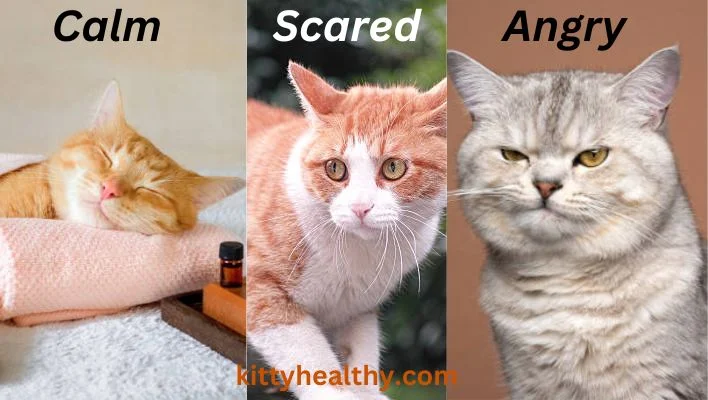Cat Behaviour: Vocalisations & Common Behavioural Patterns
Cat Behaviour is much more than just the whimsical antics and endearing idiosyncrasies we adore in our feline friends. It’s a tapestry woven with a myriad of expressions, from the subtlest twitch of a tail to the most poignant meow.
These behaviors open a window into their rich emotional lives, offering us a chance to truly understand what stirs in their hearts and minds.
As cat owners, learning to read these signs is not just fascinating, it’s essential. It helps us tune into their needs, sense their moods, and even gauge their health.
Every purr, every playful leap, every quiet gaze – these aren’t just random acts; they’re meaningful conversations in the language of cats.
By embracing this deeper connection, we don’t just become better caregivers; we become confidantes, companions, part of their trusted circle.
As we journey into the nuances of how cats communicate and relate with the world around them, we don’t just discover more about them; we discover more about ourselves and the unique bond we share with these mysterious, enchanting creatures.
Decoding Cat Body Language
Cats express a lot through their body language. Watching their tail, ears, and eyes can reveal much about their feelings and thoughts. A tail raised high often means they’re confident, whereas a tail tucked away can show fear or submissiveness.
Ears pointed forward show curiosity, and flattened ears are a sign of irritation or aggression. Eye contact in cats is complex; a slow blink can mean trust and affection, while a direct stare might be a challenge.
By understanding these cues, you can better respond to your cat’s emotional states and needs.

Vocalisations and What They Mean
Cats vocalize in various ways, each with a unique meaning. The classic ‘meow’ can be a greeting, a request, or a sign of distress, depending on its tone and context.
Purring is commonly linked to feelings of happiness, but it can also be a sign of pain or anxiety. Hisses and growls are clear signs of fear or aggression.
Understanding these vocalisations helps in deciphering what your cat is trying to communicate, enhancing your bond and ensuring their well-being.
Common Behavioural Patterns and Their Interpretation
Cats exhibit behaviors like kneading, scratching, and specific litter box habits, each with its significance. Kneading might signal contentment or mark territory with scent glands in their paws.
Scratching is not only for nail maintenance but also for stretching and marking territory. Litter box habits are crucial; changes can indicate health issues or stress. Recognising these behaviours helps in understanding your cat’s mood, health, and instincts.
Social Behaviour and Interaction Of Cat
Cats have distinct social behaviors. They may display dominance, playfulness, or affection. Understanding these social cues is vital, especially in multi-cat households.
Play is crucial for their physical and mental well-being. Observing how your cat interacts with others, be it humans or other pets, can provide insights into their social preferences and needs.
Behavioural Issues and Solutions
Here’s a table outlining common behavioral issues in cats, their possible causes, and potential solutions:
| Behavioral Issue | Possible Causes | Potential Solutions |
| Stress | Changes in environment, lack of stimulation, anxiety | Environmental enrichment, stable routine, pheromone therapy |
| Anxiety | Past trauma, separation anxiety, changes in home | Comfort zones in home, calming supplements, behavior therapy |
| Aggression | Fear, territorial behavior, past abuse | Behavioral training, neutering (if hormonal), avoiding triggers |
| Inappropriate Urination | Medical issues, stress, territorial marking | Medical check-up, litter box management, stress reduction strategies |
The Impact of Health on Behaviour
Health issues can significantly impact a cat’s behavior. Changes in behavior can be early indicators of health problems.
It’s crucial to monitor your cat for any unusual behaviours and consult a veterinarian for diagnosis and treatment. Understanding this connection between health and behaviour is key to maintaining your cat’s overall well-being.
The Role of Environment in Shaping Behaviour
A cat-friendly environment plays a pivotal role in influencing their behavior. Providing a stimulating environment with ample play opportunities, safe spaces, and consistent routines can greatly affect their mental and physical health.
Adapting the living space to suit your cat’s needs can prevent many behavioural issues and enhance their quality of life.
Conclusion
Understanding Cat Behaviour requires patience, observation, and a bit of empathy. From decoding body language and vocalisation to addressing behavioural issues and creating a cat-friendly environment, every aspect contributes to the well-being of your feline companion.
Remember, each cat is unique, and what works for one may not work for another. Embrace the journey of understanding your cat, and you’ll build a stronger, more loving relationship with your furry friend.
Related posts:
FAQs
Typical cat behaviour include purring, kneading, scratching, playing, grooming, sleeping extensively, hunting instincts, territorial marking, and using varied vocalisations like meows and hisses to communicate.
Your cat may show love through purring, head-butting, gentle kneading, following you around, bringing gifts like toys or small prey, sleeping next to you, and showing a relaxed body language when in your presence.
Cats typically exhibit independent, curious, and playful personalities, with behaviour like hunting instincts, territorial marking, grooming, sleeping for long hours, showing affection on their terms, and communicating through vocalisations and body language.
To make a cat happy, provide regular playtime, a comfortable and safe environment, attention and affection, consistent feeding routines, clean litter boxes, scratching posts, and perches for climbing and observing, ensuring both physical and mental stimulation.
When apologizing to your cat, gently and calmly approach them, present treats or a beloved toy, use a soft tone, and dedicate time to be with them. Honor their personal space and patiently wait for them to approach you, demonstrating empathy and patience.






